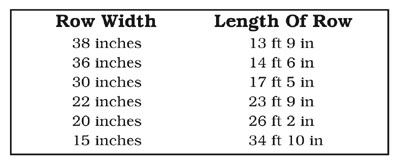|
Pioneer Talks Crops
Evaluating Corn Emergence
GREG PFEFFER
DEXTER, MO.
Welcome to Pioneer Talks Crops. This information is provided by the Pioneer agronomist serving your community.
Stand counts and stand uniformity are important factors to consider when evaluating the emergence of a new corn crop.
Stand Counts
The first step in evaluating corn emergence is to check stand counts. The following table indicates the length of row that is equivalent to 1/1000th of an acre for various row spacings.
Take several counts throughout the field and calculate an average estimated plant population. Compare the average stand count to your seeding rate to determine how successful the first step of your stand establishment was.

Stand Uniformity
The next step in evaluating new corn crop emergence is to measure stand uniformity. Getting plants to come up uniformly is a key to maximizing yield potential.
In order for corn seeds to germinate successfully there are three basic requirements: adequate temperature, adequate moisture and oxygen. Variations in temperature and moisture can create uneven timing of germination and uneven emergence.
Research by Purdue University indicates potential yield losses of 8 percent when there is a 10 day delay in emergence.
Some additional tips and requirements needed to ensure proper corn emergence include:
• Seeds that imbibe (take up) cold water are at risk for poor germination success. Dry and cold conditions are much better than wet and cold soils. Consider delaying planting if cold and wet conditions are predicted within 24 hours.
• Plant at least 10 percent above your desired final stand to compensate for early stand losses and to reduce the effect of skips.
• Plant corn a minimum of 1½ inches deep. Planting corn at a depth of less than 1½ inches in an attempt to get corn out of the ground quickly can leave plants with a shallow root system when the nodal/main roots emerge. When a corn plant begins nodal root development at ¾ of an inch below the soil surface, the plant roots are adequately anchored and are positioned to take advantage of nutrients and moisture throughout the soil profile.∆
GREG PFEFFER: Agronomist for Pioneer, Dexter, Missouri
|
|